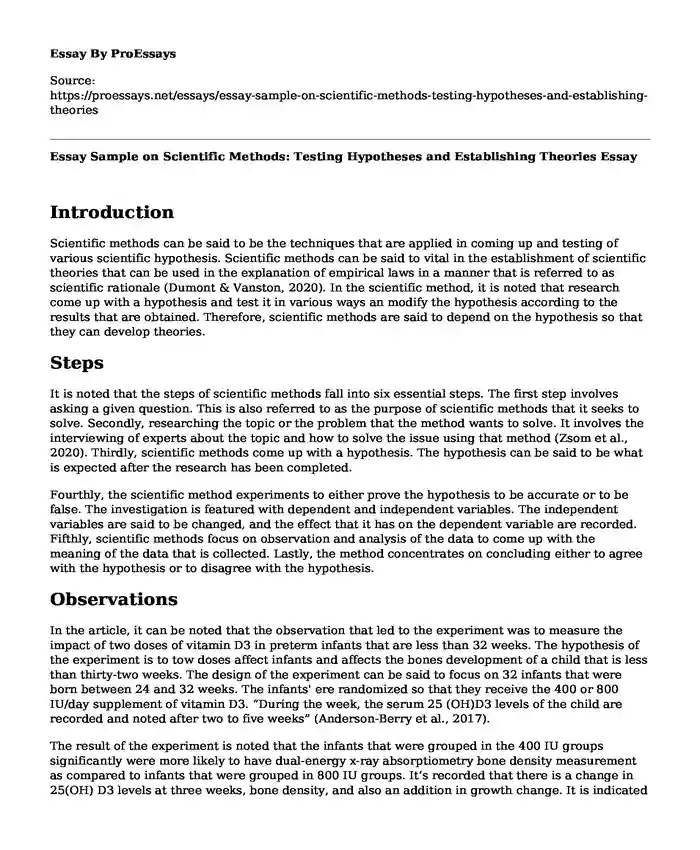Introduction
Scientific methods can be said to be the techniques that are applied in coming up and testing of various scientific hypothesis. Scientific methods can be said to vital in the establishment of scientific theories that can be used in the explanation of empirical laws in a manner that is referred to as scientific rationale (Dumont & Vanston, 2020). In the scientific method, it is noted that research come up with a hypothesis and test it in various ways an modify the hypothesis according to the results that are obtained. Therefore, scientific methods are said to depend on the hypothesis so that they can develop theories.
Steps
It is noted that the steps of scientific methods fall into six essential steps. The first step involves asking a given question. This is also referred to as the purpose of scientific methods that it seeks to solve. Secondly, researching the topic or the problem that the method wants to solve. It involves the interviewing of experts about the topic and how to solve the issue using that method (Zsom et al., 2020). Thirdly, scientific methods come up with a hypothesis. The hypothesis can be said to be what is expected after the research has been completed.
Fourthly, the scientific method experiments to either prove the hypothesis to be accurate or to be false. The investigation is featured with dependent and independent variables. The independent variables are said to be changed, and the effect that it has on the dependent variable are recorded. Fifthly, scientific methods focus on observation and analysis of the data to come up with the meaning of the data that is collected. Lastly, the method concentrates on concluding either to agree with the hypothesis or to disagree with the hypothesis.
Observations
In the article, it can be noted that the observation that led to the experiment was to measure the impact of two doses of vitamin D3 in preterm infants that are less than 32 weeks. The hypothesis of the experiment is to tow doses affect infants and affects the bones development of a child that is less than thirty-two weeks. The design of the experiment can be said to focus on 32 infants that were born between 24 and 32 weeks. The infants' ere randomized so that they receive the 400 or 800 IU/day supplement of vitamin D3. “During the week, the serum 25 (OH)D3 levels of the child are recorded and noted after two to five weeks” (Anderson-Berry et al., 2017).
The result of the experiment is noted that the infants that were grouped in the 400 IU groups significantly were more likely to have dual-energy x-ray absorptiometry bone density measurement as compared to infants that were grouped in 800 IU groups. It’s recorded that there is a change in 25(OH) D3 levels at three weeks, bone density, and also an addition in growth change. It is indicated to support the consideration of an everyday dose of 800 IU of vitamin D for children that have not reached than 32 weeks (Anderson-Berry et al., 2017).
Conclusion
In the research, the tested subject and treatment can be said to be irrelevant and inappropriate for this kind of research as it does not give the best results. The sample size was large enough since the research used 32 participants in the research. The method that was used was appropriate since it allowed the researcher to collect data every four weeks when there was progress. The potential bias in the research can be indicated as one of one variable to measure the progress of the research. The conclusion of the research does not give a clear response to the research question. The research can be said to be relevant as it used to come up with important theories.
References
Anderson-Berry, A., Thoene, M., Wagner, J., Lyden, E., Jones, G., Kaufmann, M., ... & Hanson, C. (2017). Randomized trial of two doses of vitamin D3 in preterm infants< 32 weeks: Dose impact on achieving desired serum 25 (OH) D3 in a NICU population. PloS one, 12(10), e0185950.
https://doi.org/10.1371/journal.pone.0185950
Dumont, G. F., & Vanston, S. (2020). What is a scientific method? The example of Alfred Sauvy. Les analyses de Population Avenir, (3), 1-10.
http://journals.plos.org/plosone/article?id=10.1371/journal.pone.0185950
Zsom, L., Zsom, M., Abdul Salim, S., & Fülöp, T. (2020). Subjective global assessment of nutrition, dialysis quality, and the theory of the scientific method in Nephrology practice. Artificial Organs.
Cite this page
Essay Sample on Scientific Methods: Testing Hypotheses and Establishing Theories. (2023, Nov 16). Retrieved from https://proessays.net/essays/essay-sample-on-scientific-methods-testing-hypotheses-and-establishing-theories
If you are the original author of this essay and no longer wish to have it published on the ProEssays website, please click below to request its removal:
- Blending Quantitative and Qualitative Research
- Data Collection Methods Essay
- Paper Example on Types of Polarizers
- Essay on Strategic Job Analysis: Reasons for Organizations' Strive for Competitiveness
- Essay Sample on Constructing Good Qualitative Research Questions
- Essay Example on the Pythagorean Theorem: A Pillar of Mathematics.
- Paper Sample on Eli Lilly: A Case Study on Changes in Pharmaceutical Industry







